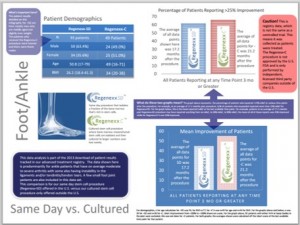Ankle Stem Cell Injections: How Do Same Day vs. Cultured Stack Up?
Yesterday I compared how same day stem cells used for hand arthritis compared to cultured cells as a hand arthritis surgery alternative – the differences seemed stark for patients with severe thumb arthritis. How do ankle stem cell injections with a same day stem cell procedure (Regenexx-SD) compare to cultured cells?
For this infographic I took patients from our advanced treatment registry who had been categorized as ankle/foot. The vast majority of these patients in both analyses have large ankle joint arthritis (Tibio-talar), with a few patients having either sub-talar or small foot joint arthritis. For the same day data set, patients with avascular necrosis or loose bodies in the joint were not included; for the cultured procedure all patients were included. As you can see from the graph above, there does appear to be a difference between these two procedures with the cultured procedure providing a better overall result, but, the differences aren’t as stark as for hand arthritis. This difference is more in line with what we see with knee arthritis. In addition, recognize that unlike our knee arthritis data, these data sets are smaller, so as more data is collected and reported these differences could grow smaller, stay the same, or grow larger.
The upshot? So far, cultured stem cells do appear to have an edge over same day treatments for ankle arthritis, but the differences don’t seem to be as stark as they were for hand arthritis. As always, click on the thumbnail above to see the more detailed PDF.
The Regenexx-SD procedure is used in the U.S. (same day), while the cultured stem cell procedure (Regenexx-C) is not U.S. FDA approved and is only used via license to companies that operate outside of the U.S. for use wholly in a country that allows such use.

NOTE: This blog post provides general information to help the reader better understand regenerative medicine, musculoskeletal health, and related subjects. All content provided in this blog, website, or any linked materials, including text, graphics, images, patient profiles, outcomes, and information, are not intended and should not be considered or used as a substitute for medical advice, diagnosis, or treatment. Please always consult with a professional and certified healthcare provider to discuss if a treatment is right for you.

